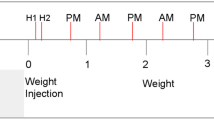Abstract
IN the course of experiments using young guinea pigs as test animals, it was found that erythromycin given orally or intraperitoneally caused the animals to look ill after two to three days, with ruffled fur, anorexia, disinclination to move and subnormal temperature, followed by death on the sixth to eighth day with emaciation and signs of diarrhœa. No obvious common cause of death could be found macroscopically or microscopically in sections of liver, spleen, kidney or lung, although occasionally liver necrosis and renal tubular degeneration were seen, accompanied by albuminuria, red cells and casts in the urine and slightly raised blood urea.
This is a preview of subscription content, access via your institution
Access options
Subscribe to this journal
Receive 51 print issues and online access
$199.00 per year
only $3.90 per issue
Buy this article
- Purchase on Springer Link
- Instant access to full article PDF
Prices may be subject to local taxes which are calculated during checkout
Similar content being viewed by others
References
Anderson, R. C., Harris, P. N., and Chen, K. K., J. Amer. Pharm. Assoc., 41, 555 (1952).
Author information
Authors and Affiliations
Rights and permissions
About this article
Cite this article
KAIPAINEN, W., FAINE, S. Toxicity of Erythromycin. Nature 174, 969–970 (1954). https://doi.org/10.1038/174969b0
Issue Date:
DOI: https://doi.org/10.1038/174969b0
This article is cited by
-
Erythromycin Exposure Disrupts the Life Cycle Stages of Aedes aegypti L. (Diptera: Culicidae)
Water, Air, & Soil Pollution (2018)
-
Toxicity of Erythromycin
Nature (1957)
Comments
By submitting a comment you agree to abide by our Terms and Community Guidelines. If you find something abusive or that does not comply with our terms or guidelines please flag it as inappropriate.



